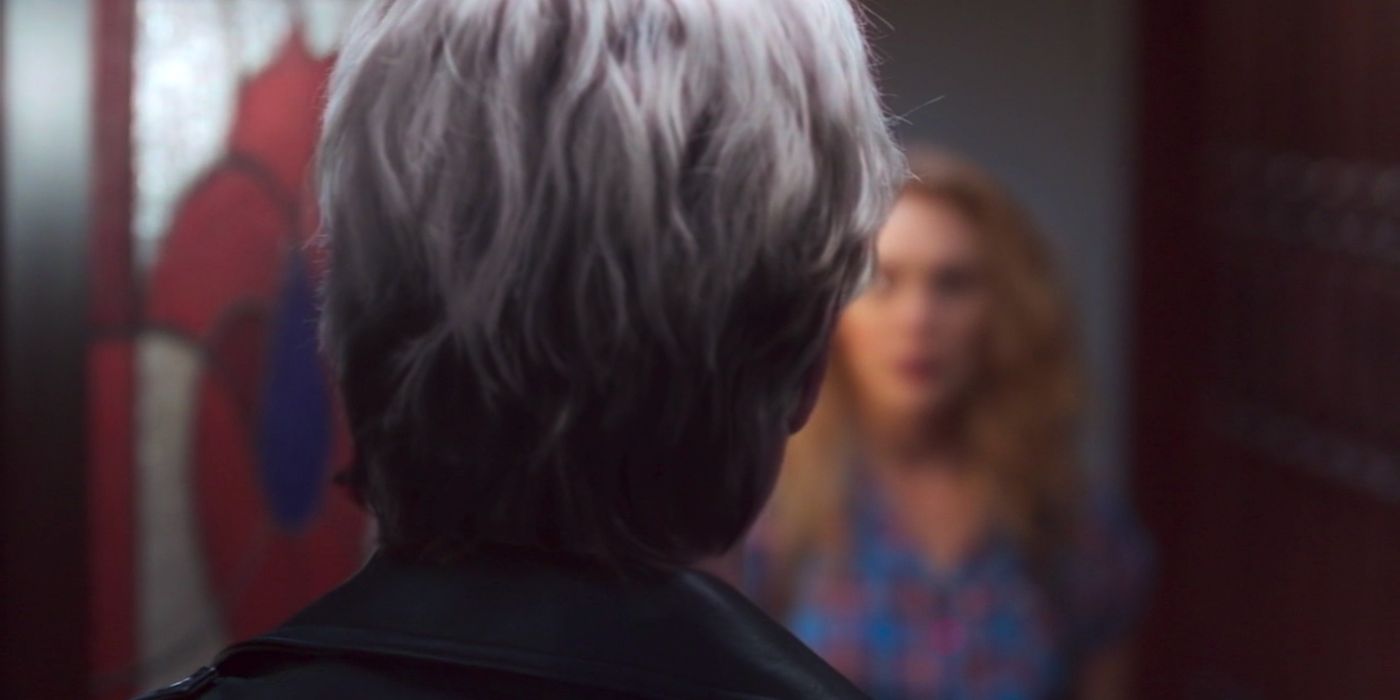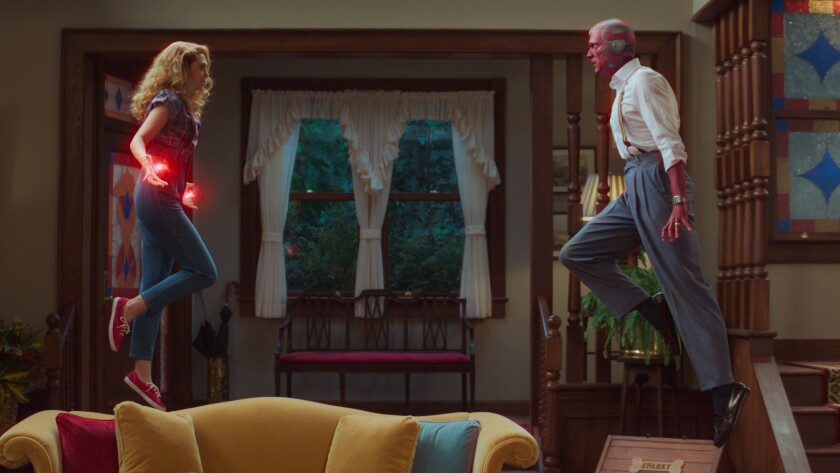Disney+’s WandaVision is a bonafide pop-culture event. Wanda and the Vision’s surreal, tragic love story has gripped us here at Nerds On Earth in a way rivaled only by the twists and reveals of The Mandalorian. (The House of Mouse really has assembled the Holy Trinity with Kevin Feige, Dave Filoni, and Jon Favreau, haven’t they?)
The WandaVision hype is justified—the sitcom homages are pitch perfect, Vision’s confusion is balanced by a solid dose of action, and Elizabeth Olsen is simply a revelation. This gem of a show deserves more than gushing superlatives, though, for three reasons:
- WandaVision’s connective tissue opens up a panorama of possibilities.
- The show has a TV twin, one with a shared reverence for pop culture.
- It demonstrates how pop culture provides a lens for processing trauma.

So Much With So Little
Marvel has emphasized the importance of WandaVision for years now. Marvel Cinematic Universe mastermind Kevin Feige was talking about the show even before COVID-19 sent the planet for a long and torturous loop. Halfway through the season, it’s now clear that Feige wasn’t exaggerating: WandaVision is the launching point for Phase 4 of the MCU, the huge multi-film-and-show slate set after the events of Infinity War and Endgame.
WandaVision has a lot riding on its costumed shoulders. It juggles both short- and long-term implications, setting up storylines that won’t be resolved (or even revealed) for years. The show does a lot of heavy lifting in just nine episodes; the astounding thing is the absolute mastery with which it does so. Consider Firefly (14 episodes), Twin Peaks (48 episodes), or Freaks and Geeks (18 episodes)—these legendary shows told amazing stories in a compacted format, but none of them did it, or introduced as much additional content, in as short a lifespan as WandaVision.
The last two episodes alone have opened enough cans of worms to send fans high into the thin, glorious air of the nerdosphere. Only halfway through the show we can legitimately consider several different, equally awesome futures:
- The fifth episode’s shocking reintroduction of Pietro Maximoff, Wanda’s dead brother, is more than an emotional gut punch—it’s the cleverest bit of corporate and storyline synergy in modern entertainment history. Pietro is played in the scene by Evan Peters, the actor who played Quicksilver in the X-Men films made by 20th Century Fox, not Aaron Taylor-Johnson, the actor who played Pietro in the Disney-produced Avengers movies.
- Casting Peters in WandaVision allows Disney a nifty explanation for why the old X-Men never got to meet Thor or Groot: they exist in a separate universe! Thanks to Wanda’s immense powers (and the background info established in Endgame), those universes are starting to collide. Evan Peters/Quicksilver is just the first sign of crossovers to come.
- That multiverse sets up Doctor Strange in the Multiverse of Madness, Shang-Chi and the Legend of the Ten Rings, and the next Spider-Man movie (rumored to be an absolute clown car of Spider-people and villains from the various film series).
- Monica Rambeau’s throwaway reference to an “aerospace engineer” she knows tees up the introduction of any number of new characters: Riri Williams (the teenage superhero Ironheart, who has her own upcoming Disney+ show), Reed Richards of the Fantastic Four (rumored to be played by John Krasinski), or even relative obscurity the Blue Marvel.

“Wanda & Abed in the Morning!”
Part of WandaVision’s strange charm are the loving homages to classic TV sitcoms. We’ve seen the show openly copy (and affectionately spoof) The Dick Van Dyke Show, Bewitched, The Brady Bunch, I Love Lucy, Family Ties, Full House, and more so far. Every new tribute reminds me of another TV wunderkind: Community. The perennially on-the-edge-of-cancellation NBC comedy became legendary for its elaborate homage episodes. There were riffs on Armageddon, The Good, The Bad, & The Ugly, Goodfellas, and even My Dinner With Andre. And like WandaVision, its recreations were tonally and visually spot-on.
Some of Community’s tributes were pretty detached from the show’s reality (I’m talking about you, “Regional Holiday Music”), but the best served as important additions to the show’s storylines and character development. Many of Community’s TV and movie references are driven by Danny Pudi’s Abed Nadir, the show’s emotional heart. Abed’s lack of social skills and inability to process emotions (heavily implied to be caused by his undiagnosed Asperger’s syndrome) cause him to lean heavily on pop culture tropes.
The movies and shows Abed loves help him understand his loneliness, emotionally frigid home life, and maternal abandonment issues caused by his parents’ divorce (for which he blames himself). Abed can work through the trauma only by viewing it through the lens of pop culture. As he says, “It’s TV; it’s comfort. It’s a friend you’ve known so well and for so long you just let it be with you.” He separates himself from the pain of real life by thinking of himself as a character in a movie or show. Remind you of anybody in WandaVision?
“It’s TV; It’s Comfort.”
We’ve learned over the first half of WandaVision’s run that the show is an intricate simulation, one either created or (partially) controlled by Wanda Maximoff. It’s increasingly obvious that Wanda, unwilling or unable to process the Vision’s death (and her part in it) at the hands of Thanos, has chosen instead to create a “perfect” sitcom version of what their lives together would’ve been like. Like Abed, Wanda cannot or will not engage with the painful reality of her trauma: Vision is gone, and he can’t be brought back.
Instead she retreats into the comforts of TV sitcoms, with their laugh tracks, squeaky clean kitchens, lovably odd side characters, and small troubles always resolved by the time the credits roll. The tropes of classic television provide a framework against which Wanda can project her grief, morphing to fit what might have been and reassembling the broken pieces of her life into something better. (WandaVision even gives us Jeff Winger-esque characters who point out the false reality that Wanda has established in Randall Park’s Agent Woo and Kat Dennings’ Darcy Lewis. They function as in-universe audience members of Wanda’s “show”.)

But TV is no substitute for real life, at least not for long. Abed can’t ignore his mom’s refusal to spend Christmas with him, even with a rad claymation Christmas special; Wanda can’t deny that Vision is dead, even if she can roll credits over his befuddled anguish. As he shouts, “I can’t remember my life before Westview. I don’t know who I am! I’m scared!” the repressed power in their confrontation and the rising panic in her eyes show that Wanda’s grip on this perfect TV reality is slipping. Sooner or later, she’ll have to face the trauma of Vision’s death. In the meantime, let’s use the lesson we learned from watching Abed on Community: just sit back and enjoy the show.

